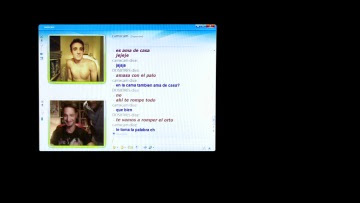

|
|
Third One (The) AKA El tercero
R1 - America - TLA Releasing Review written by and copyright: Eric Cotenas (29th December 2014). |
|
The Film
 Twenty-two-year-old student Fede (Emiliano Dionisi) has been chatting online with an older gay couple – outgoing Franco (Nicolás Armengol) and the more reserved Hernán (Carlos Echevarría) – and working up the nerve to meet them in person for a hook-up. Having psyched himself up for a steamy one night stand, he arrives at the couple's apartment to a very domestic dinner; and it seems as if he is not the only one who has perhaps lost their nerve. Polite dinner conversation takes on a more candid tone thanks to too much drink, rich food, and a number of observations that begin with "After eight years…" from the couple. Fede's confessions of his insecurities – inheriting his early receding hairline from his father and fearfulness from his mother who committed suicide – endear him to the couple (who come to see him as not the easy hookup they met on the internet but a young man up for adventure in spite of his timidity). Conversely, Fede starts to feel closer to the couple as they make him explain to him the in-jokes and incidents behind their jabs at one another (which start to see more good-humored rather than expressions of underlying dissatisfaction with their long term relationship). Written and directed by Rodrigo Guerrero, The Third One feels like a short play expanded by what happens offscreen both before and after; so much so that the "climactic" threesome sex scene feels almost obligatory however steamy (though thankfully far less "clinical" than the crass hardcore flashes of videos on Fede's desktop during the fifteen minute pre-credits sequence). The final scenes start to drag and feel extraneous but eventually convey a positive internal change in one of the characters' outlook on life. The intimate setting is less of a budgetary limitation than a choice suited to the play-like feel and the nature of the proposed encounter between the three characters (indeed, there is almost a nineties New York indie film feel to the piece), and the long take approach to the "second act" scenes does hold the viewer's attention to the dialogue (turning the trio into developed characters rather than decorative props for the "climactic" scene). The lensing of cinematographer Gustavo Tejeda is colorful and intimate, unobtrusive in the lengthy dialogue passages and monologues while making creative use of all four edges of the frame during the sex scene (so as to maintain focus on the actors while teasing with what is happening just beyond the frame). While not a substantial work, The Third One shows promise as a sophomore effort (the director's debut having been four years previous as the arty but shapeless The Winter of the Odd Ones Out).
Video
TLA Releasing-offshoot Canteen Outlaws' single-layer, progressive, anamorphic 1.78:1 transfer is sufficiently encoded with a clean and colorful image and minor edge-enhancement. The English subtitles are encoded into the image and unobtrusive, only becoming difficult to read during a lengthy dialogue scene composed of two reverse angles where the subtitles appear against Fede's light colored shirt.      
Audio
The Dolby Digital 2.0 stereo audio track seems to be the original mix. It's a dialogue-heavy film with minimal music and stripped-down sound design.
Extras
There are no extras apart from the film's trailer and trailers for My Straight Son and Floating Skyscrapers which appear as start-up trailers but also play after the feature's trailer from the main menu.
Packaging
There are two posters for the film that utilize the same image. One of them is moodier with red lettering and has higher contrast with darker shadows and almost solarized highlights. Canteen Outlaws' keepcase reproduces the brighter, hazier version.
Overall
|
|||||

|